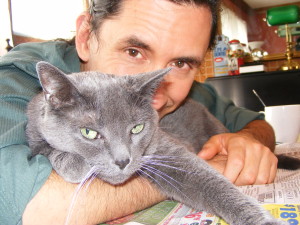On December 6, our family will participate in the annual Hot Chocolate Run/Walk for Safe Passage, the main fundraiser for Hampshire County’s domestic violence shelter and services provider. We hope you’ll feel moved to sponsor us here.
Our community is unusually fortunate to have a domestic violence program that is trained to serve the LGBTQ population. It’s often extra-hard for queer victims to seek help, because they fear that police and social workers will be biased against them, or that airing negative images of same-sex relationships will set back the civil rights struggle. Additionally, some queer victims don’t recognize that their relationship is abusive because it doesn’t look like our mainstream cultural image of the heterosexual wife-beater. Speaking for myself, the lightbulb only went on when I attended an LGBT-inclusive volunteer training class at Safe Passage. I’d been abused for 30 years without having a name for it.
UK-based blog The Queerness explored this problem in the recent article “LGBTQ+ Domestic Violence: The Silenced Issue”. Journalist Stephanie Farnsworth writes:
Recent studies are proving that abuse is an issue within same gender relationships and this must be acknowledged. One study found that 21.5% of men and 35.4% of women in same gender relationships experienced intimate – partner physical violence during their lifetimes compared with only 7.1% of men and 20.4% of women who cohabited with a partner of a different gender. 34. 6% of transgender people (regardless of gender of the partner) experienced intimate partner violence also in a study from 2014.
Another study, conducted by the CDC in 2010*, of over nine thousand women (96.5% were straight, 2.2% bisexual and 1.3% lesbian) found that while 35% of straight women had experienced rape, physical violence and/or stalking by an intimate partner it was even more common for bisexual and lesbian women. 43.8% of lesbians had experienced one of the three categories, while 61.1% of bisexual women had and this is even with the lower turn out rates of bisexual and lesbian women in the study which is suggestive of a much more serious epidemic of intimate partner violence that LGBTQ+ people experience. Additionally, trans people (particularly non binary trans people) are still often ignored within research and so the true realities for their experiences are being silenced – this is despite the fact that it is widely accepted that trans women are especially at risk of assault in general and so should be considered as an at risk group for experiencing domestic/intimate partner abuse.
This erasure and the limited way we think about domestic violence is dominating the narrative and leaving survivors isolated. As a consequence of the still very narrow and binary gender stereotypes and expectations we have, men are erased as victims of violence and it is believed that women can never be perpetrators. It isn’t uncommon for these stereotypes to be so prevalent that even those experiencing abuse do not see what is happening. Gay and bisexual men have brushed off assaults as just something they assumed that was natural to being in a relationship with a man, and women often do not think that the woman they are with would be capable of committing any form of abuse due to her gender. These ideas are so engrained in society that even domestic violence charities still don’t seem like welcoming or understanding places for many LGBTQ+ people. The 2010 Equality Act also means that trans women can be turned away from women’s shelters despite the fact that logically this is a clear violation of non discrimination legislation (included within the same piece of legislation). Furthermore, intimate partner violence has often been focussed upon by feminist movements in an entirely cis-centric way with the emphasis on patriarchy and (cis) male violence which has exacerbated this issue around one dimensional beliefs about abuse. The focus is generally centred around cis, heterosexual women in monogamous relationships and often with children, yet this approach has completely erased LGBTQ+ victims and this isolation puts them in further harm with little support available in society and very little understanding.
Jasna Magić, researcher at Broken Rainbow, noted that while mainstream services were generally welcoming in attitudes to LGBTQ+ people there was little consideration of the specific experiences and issues they would face. There was often positive will behind support workers but good practice was lacking. She added that this was an issue that charities would struggle to overcome as a result of financial cuts; mainstream organisations would not be able to invest in equality and diversity training for its staff or in resources which helped promote better approaches to LGBTQ+ survivors. Magić also reinforced that abuse within LGBTQ+ people’s relationships was often not recognised either by society or by survivors themselves.
LGBTQ activist Rev. Irene Monroe’s article from October 2015, “Same-Sex Domestic Violence Remains on the Down Low”, raises another important topic, the intersection of multiple oppressions when victims are queer people of color:
…It’s estimated that 25 percent to 33 percent of the LGBTQ population will experience some form of partner abuse or domestic violence in their lifetime. The Inter-Personal Violence study conducted in 2011 stated that LGBTQ communities of color are one of the demographic groups experiencing a high incidence of domestic violence. However, it’s often hard to determine accurately how prevalent interpersonal violence is in these communities because of social stigmas and cultural taboos that prevent people from accurately reporting abuse. Other forms of oppression and discrimination figure in this as well.
What also prevents the gathering of accurate data in these communities of color is that same-gender interpersonal violence is clouded with myths. There is a belief that because the victim and the abuser are of the same gender, and are also in a consensual sexual relationship, the battering that occurs starts out as a mutual act of S&M. Another myth is that same-gender sexual abuse is not as bad because men and men and women and women are on equal playing field when it comes to defending themselves. Sadly, these untruths still abound among many health care workers and law enforcement officials…
…with violence associated with young black males, the protocol and treatment for domestic violence-related injuries in inner-city hospitals for these patients are rarely introduced or followed up…
…In same-race relationships, many victims will often not prosecute their partners for fear of community abandonment, isolation, and scorn. Rather, some rationalize the violence as the root cause of persistent micro and macrolevels of racism their partner encounters…
In addition to Safe Passage, I have heard good things about The Network/La Red, a Boston-based shelter and survivor advocacy group with an intersectional approach. Their website says:
The Network/La Red is a survivor-led, social justice organization that works to end partner abuse in lesbian, gay, bisexual, transgender, BDSM, polyamorous, and queer communities. Rooted in anti-oppression principles, our work aims to create a world where all people are free from oppression…
…Partner abuse exists to achieve and maintain control, and reflects and perpetuates the larger violent culture which condones and rewards interpersonal, institutional and imperialist abuse of power in order to control and/or exploit groups of people. The Network/La Red links domestic violence to all other forms of violence, oppression and abuse, because the values and tactics behind each are identical.
Donate here.





